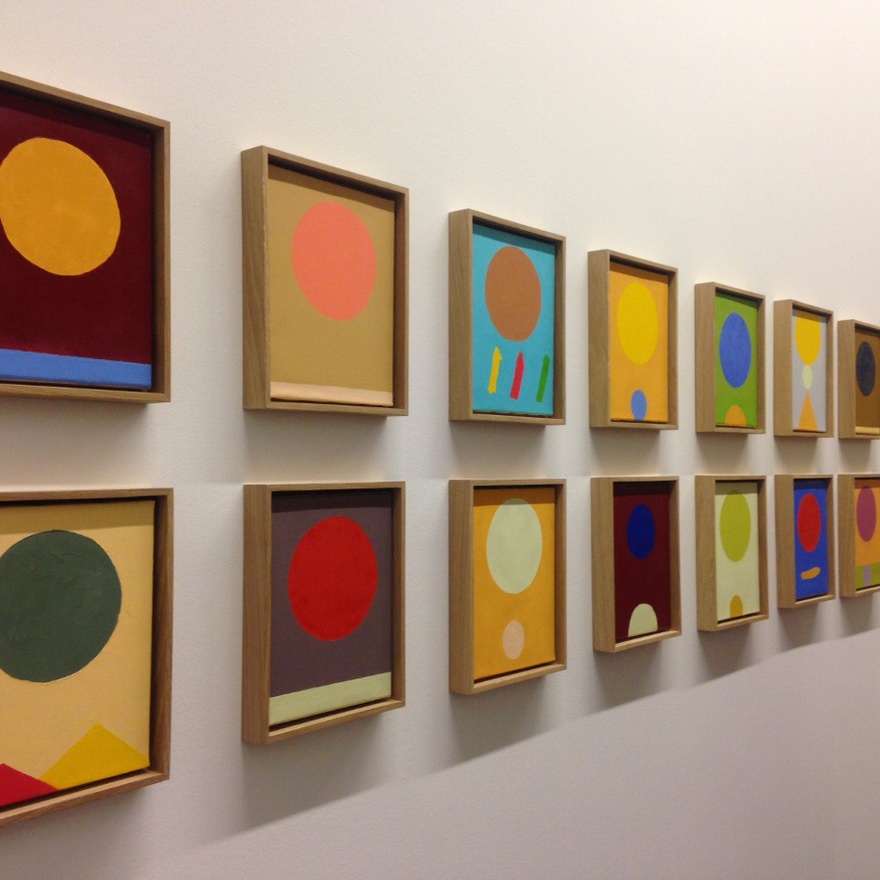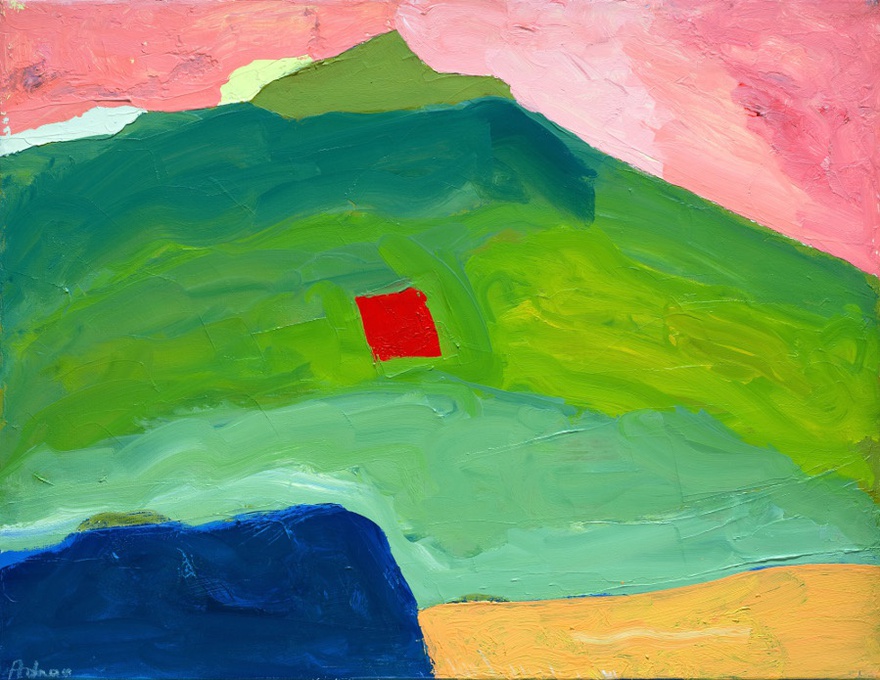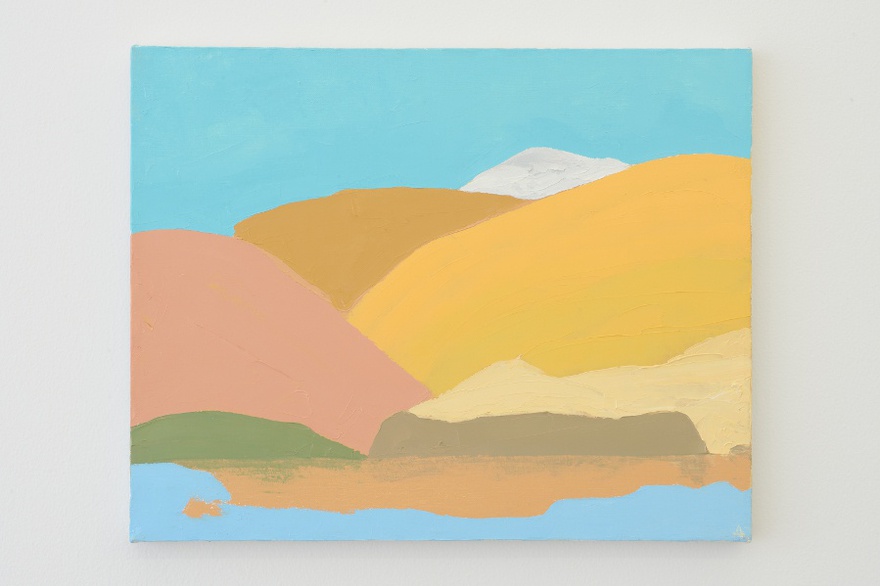Reviews
The Weight of the World
Etel Adnan at Serpentine Galleries
'Everything that happens brings about something else that you can't foresee', says Etel Adnan. 'Things are more unexpected than we know. That's what makes things alive.'[1] The 91 year-old Lebanese artist was referring to the inspiration behind her newest series of paintings, Le poids du monde [The Weight of the World] (2016). The canvases were based on a comment made by Serpentine Gallery artistic director Hans Ulrich Obrist on a visit to Adnan's studio in Paris. As the story goes, Obrist saw a painting Adnan had titled The Weight of the World and told her that she should do more of them. 'I never intended for that first work to turn into a series', she recalls.
This anecdote is both an insight into how curators directly influence artists and their production and Adnan's deeply reflective practice, in which life, philosophy and creativity become intertwined. This is undoubtedly rooted in the fact that Adnan was a teacher, writer and philosopher long before she took up painting. (Adnan read philosophy, first at the Sorbonne in Paris and later at Berkley and Harvard.) Before finding fame as a visual artist, she was better known as an award-winning writer for novels such as Sitt Marie-Rose (1978), which is often described as the defining novel on the Lebanese Civil War, and books of poetry including Arab Apocalypse (1980). Her chameleon-like ability to turn her artistic talents to a variety of creative outputs is one of the things that makes Adnan so compelling as an artist and is also what makes her solo exhibitions, displaying the breadth of her work, so stimulating.
Over the last decade, Adnan's position as a contemporary master within the international art scene has been firmly sealed. Many pinpoint Adnan's widely acclaimed participation in 2012's dOCUMENTA (13) as the moment that her work really gained global attention, although she had been exhibiting regularly, particularly in California and Beirut, since the early 1960s, and has strong institutional recognition in the Middle East, with her work found in museum collections such Mathaf, Doha; the Royal Jordanian Museum; Tunis Modern Art Museum; and the Sursock Museum, Beirut. More recently, Adnan has held a number of solo shows, including those staged at Callicoon Fine Arts, New York (2012); White Cube Bermondsey, London (2014); Mathaf: Arab Museum of Modern Art, Doha (2014); and the Irish Museum of Modern Art, Dublin (2015). She has also been featured in important group shows such as Here and Elsewhere at the New Museum (2014) and the Whitney Biennial at the Whitney Museum of American Art (2014), both in New York; as well as the 2015 editions of the Sharjah Biennial and Istanbul Biennial. Therefore, it might seem surprising that Adnan's show The Weight of the World at the Serpentine Sackler Gallery is the artist's first with a UK public institution. This is somewhat telling of Adnan's greater recognition in America, where she has lived most of her life and where she is increasingly considered as part of the post-war American art canon.[2]
To this end, The Weight of the World offers an introduction of sorts by offering a survey of the diverse range within Adnan's practice, using more than 70 works dating from the early 1960s to today. The exhibition is small in size, particularly when compared to the artist's 2014 retrospective at Mathaf, which featured more than 160 works, but viewers are nonetheless presented with a remarkable glimpse into the breadth of Adnan's oeuvre, from her distinctive abstract paintings to examples of drawings, tapestries, poetry, and film. The show is arranged chronologically around the gallery's central room, and is divided into four main sections: paintings and drawings from the 1960s to 1980s, described as a period of 'experimentation'; leporellos, oil paintings and watercolours that feature mountains as their subject; oil paintings from 1995 to 2014, which are abstract and small in scale; and the entrance (also the exit) area, which displays new tapestry works and Le poids du monde, a series of 20 small oil on canvas works. In the centre of the gallery are two raw brick spaces that showcase Adnan's film Motion (1980–89/2012) and four leporellos (accordion-folded sketchbooks) and two large wooden screens depicting city scenes.
At first glance, the exhibition seems like an inoffensive but ultimately unreflective introduction of Adnan to a general UK public that are perhaps unfamiliar with her practice. But the exhibition also offers a subtle curation of Adnan's work that counters the widely-held preconceptions of the artist simply as a painter of brightly coloured, semi-abstract landscape canvases.
The most striking works in the exhibition are some of Adnan's newest. Hanging prominently in the entrance of the gallery are four vibrant, abstract tapestries, including Marée Basse [Low Tide] (2015) and A Window Through a Window (2016). They are a bold introduction to the show – much larger than Adnan's other works at almost two metres wide. And although they feature the bold bright colours for which the artist is renowned, the abstraction presented is strikingly different to those we have come to know through her canvases, which generally represent landscapes composed of swathes and blocks of brightly coloured paint. The specific designs for these textiles come from a series of drawings that Adnan made in the late 1960s and early 1970s, although the tapestries themselves were only made recently. The designs seem more painterly than Adnan's paintings themselves, created as they were with more distinct lines that resemble brush strokes. Nearby, the series Le poids du monde offers a contrast that demonstrates the abstraction that Adnan has been exploring in the last 50 years and that the exhibition as a whole attempts to capture. The 31 by 25 centimetre works are small, with each canvas using only three or four bold colours and featuring a large circle at the top, accompanied by a few other forms below.
The two rooms in the centre of the exhibition space are both engaging and challenging. The works on display use a predominantly black and white palette that seems startling when coming from the sea of colour in the main gallery space. Here, vaulted ceilings, bare brick walls and slightly dimmed lighting gives the impression of a sanctuary and amplifies the sombre and contemplative aspects of the works presented. In the first room is the video Motion, a 90-minute collage of scenes of New York in the 1960s, shot on a Super 8 camera. In muted colours, the snapshots flit from images of towering buildings to open skies and moving water. The film is a poetic contemplation of light and its reflections – a central element of inspiration for Adnan – and the result is somewhat disorientating but incredibly peaceful. The second room displays leporellos and wooden folding screens (which almost act as larger versions of the folded sketchbooks themselves), each featuring fluid black lines on white backgrounds. The leporellos depict the skylines of New York and San Gimignano, a medieval hill town in Italy. A Japanese influence is noticeable in the works – it was, in fact, the discovery of Japanese leporellos in 1964 that inspired Adnan's use of the form and she often uses Japanese ink in these works on paper. The wooden screens are also reminiscent of Japanese-style room dividers, and are particularly distinctive. The simple black outlines of San Gimignano hand-painted on lightly marbled translucent alabaster have an ethereal effect. As the light shines through and one moves around the work, experiencing the zig-zagged fracturing of the image, the scene changes and becomes blurred and disjointed. It is within these works that Adnan's style seems most free and energetic, capturing the ideas of light and shadow that she is always aspiring towards. This curation of Adnan's work – stripped of colour, natural landscapes and oil paints – is a refreshing and challenging reconsideration of the artist that allows other important aspects of the work, such as light, movement, and poetry, to take greater prominence.
It is disappointing that the exhibition is somewhat lacking in description in the form of wall texts (there is, of course, a catalogue available to buy), leaving the works to speak for themselves. While Adnan's style is easy to appreciate on a purely aesthetic basis, the lack of explanation belies some of the essential context that elevates Adnan's work to a level greater than the visually pleasing. Nevertheless, this survey is an effective introduction to Adnan's practice that also offers old admirers an alternative perspective on what are now classic pieces of art.
Etel Adnan: the Weight of the World is on show at the Serpentine Sackler Gallery, London, until 11 September 2016.
[1] Etel Adnan in conversation, 5 May. A short version of this interview was published in The Art Newspaper. Aimee Dawson, 'California landscapes resonate in London,' The Art Newspaper, 1 June 2016, www.theartnewspaper.com/shows/california-landscapes-resonate-in-london
[2] Maymanah Farhat, 'Paintings and Drawings: Etel Adnan,' Art Asia Pacific, November/December 2013, http://artasiapacific.com/Magazine/86/EtelAdnan

















